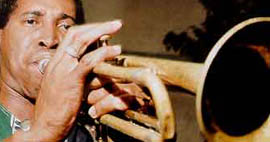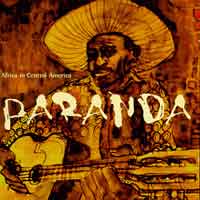Roots recordings of indigenous and African-descent peoples of Central America have not generally enjoyed the attention lavished on other world folk traditions. But several essential recording projects, past and present, testify to the expressive power of vital but relatively unknown music cultures from Belize, Guatemala and Honduras.

The second volume presents the music of Guatemala's Garifuna (formerly known as the Black Carib). The Garifuna are a culturally hybrid, multilingual people of Afro-Amerindian descent who never submitted to slavery. They populated Central America's Atlantic coast from Belize to Nicaragua after English colonial forces defeated them in their native St. Vincent in 1797, sending them into western Caribbean exile in the Bay Islands, Honduras. Garifuna singing and drumming show keen affinities with other musics of the African diaspora, a fiercely percussive, communal call-and response formulation rooted in the sacred context of ancestral invocations and spirit possession, as in Cuban Santería, Haitian Vodoun and Brazilian Candomblé.
Garifuna music builds on an ensemble of two and preferably, three garaon drums: the improvising primera or heart drum, the counter-rhythmic segunda or shadow drum, and the steady bass-line tercera. An unusual adaptation is the snares, one or two guitar strings or wires stretched over the drumhead to achieve the buzzing sound also favored in some West African music cultures. This lends a highly valued denseness to the musical soundscape, which may deceive the ear as an artifact of electronic distortion in the recording process. Other instruments include turtle-shell percussion, claves, bottle percussion and a variety of shakers and scrapers. In secular terms, the most salient Garifuna genres are punta and paranda. Spanish for "carousal," paranda adds the guitar to the garaon ensemble. The salacious paranda couple dance recalls the pelvic thrust or vacunao of the Cuban rumba guaguancó; it also recalls the scandalous palo de mayo of Nicaragua's Atlantic coast, but that's impressionistic, not an authoritative claim.
Three Garifuna groups from the Caribbean coast perform on the Caprice title. Suamen is the most traditional, combining an acute female vocal chorus with the garaon duo and diverse percussion. Ugandani augments three acoustic guitars with electric bass, but covers a traditional repertoire associated with wakes and the Christmas custom of going house to house soliciting small gifts of food, drink and money. The Garifuna Boys favor a contemporary sound called punta rock, an increasingly popular regional dance style (the unfamiliar ear might gloss it as soca). It adds keyboards, electric bass and occasional brass and synthesizer to the core drum and percussion ensemble. But the Garifuna Boys retain a sense of traditional proportion, not always the case elsewhere in the isthmus. Whether they realize it or not, every dancehall-cruising budget traveler to Central America has heard the jacked-up takeoff of punta rock that conferred a species of pop notoriety upon a number of regional pick-up groups (e.g., Banda Blanca, Banda Impacto, Los Gatos Bravos, Grupo Ebano, Los Profesionales, Chico Ramos, Los Roland, Los Silver Star, Sopa� all wildly popular, listener discretion advised).
Ethnomusicologists were first to record Garifuna music, which missionaries had long sought to discourage, condemning as the devil's work the music's association with spirit possession rituals. Researcher Doris Stone worked in Honduras in the early 1950s, and her field recordings, including those of the Garifuna, appeared soon thereafter on Folkways Records. Founder Moses Asch, a seminal figure in "world music" before the concept knew its own name, left nearly 2,200 exceptional titles when he died in 1986, whereupon the catalog passed to the Smithsonian. In consequence, these unique documents are available once again, this time via the inspired Smithsonian Custom Compact Disc Series: Pick your title, file your request, and wait for the CD version in the post. The Black Caribs of Honduras presents secular and sacred music, including healing and possession songs associated with the dugú, along with paranda, punta and jonkonnu, a carnivalesque street music performed door-to-door during the Christmas season. This is music at its rawest, deep sociocultural context. Female voices are prominent, indeed they rule, reflecting the belief that women are more attuned to the domain of the ancestral spirits. But forget about inviting yourself to a dugú ceremony; it's not a tourist attraction, and you won't be welcome. You don't have the endurance anyway; they can go on for days.
Released originally in 1955, Songs and Dances of Honduras introduces popular forms rooted in the colonial era. Associated with the majority Spanish-speaking mestizos (of primarily Spanish-Amerindian descent), the music combines guitar, the three-string tiple, violin, maracas (a pre-Columbian instrument), and along the western border with Guatemala, the marimba. The genres Doris Stone recorded include children's lullabies, the quisique or sique couple dance, fandango, corrido, vals and rumba (a radio insurgency from Cuba to all of Central America and Mexico). Living in rural Honduras in the early 1980s, I found these and related forms, the bolero especially, to be ubiquitous among village musicians, and I met some brilliant guitarists and vocal harmonists during that time, folk artists who never recorded, alas, but equal, in my estimation, to the trio gods, Mexico's Los Panchos, or Cuba's Matamoros. Ethnomusicologists Carol and Travis Jenkins worked in Belize some three decades after Stone's Honduras field efforts. The secular and sacred Garifuna music Jenkins and Jenkins documented, originally issued by Folkways in 1982, are now available in the Smithsonian Custom Compact Disc Series. These are essential titles for anyone who wants to explore this music in depth. Certainly, the recording quality is superior to Stone's earlier work, a technological artifact that takes nothing away from her pioneer endeavor. Together, the work of Jenkins and Stone enable a historical comparison that confirms the conservative aesthetic at the core of a dynamic Garifuna tradition. Having lived in Belize, and knowing Garifuna communities down the Caribbean coast into Guatemala, Honduras and Nicaragua, it is clear that the cultural, socioeconomic and political circumstances under which they live have not improved markedly, and music in everyday context reflects that fact. On the other hand, international radio broadcasts, satellite TV, VCRs, cassette culture, tourism's impact and the dynamics of international migration work their own cultural alchemy, with mixed results in terms of changing tastes and musical practice. Garifuna music is anything but a static creation, which underscores the critical contribution of more recent recordings. 
For instance, Paranda: Africa in Central America, (Erato Detour), recorded in 1998, presents six Garifuna paranderos and a punta rocker sprung from paranda. The artists, spread remarkably between 27 and 94 years of age, hail from the Caribbean coast of southern Belize and Guatemala. The call-and-response vocals and piercing harmony ride over a mournful, driving, minor-key guitar that achieves its arresting effect in part by tuning down a half-tone or more. Without exception, these men are astounding singers and instrumentalists. Their voices emerge from somewhere deep within, and the stories they can tell. A persistent story since the end of World War II has been Garifuna men's emigration in search of work, while women, children and the elderly stayed behind. Except that today, entire families move in a transnational circuit that links Central America with cosmopolitan Garifuna communities in New York, Chicago, Miami, New Orleans, Houston and Los Angeles. Musicians have assimilated hip-hop, rap, soul, rhythm and blues, jazz, pop, country western, rock, reggae, Latin, Afro-Caribbean and world musical influences, including guitar and vocal styles reminiscent of West Africa, all turned out in superb musicianship, pointed good humor and profound irony. Chatuye, based in Los Angeles, is exemplary. A constantly shifting collective of Garifuna musicians from Belize, Chatuye appears unmoved by the reductive logic that has led some of their paisanos to embrace the synthesizer, drum machine and female cleavage quotient of international Latin pop. Chatuye stands firm, a purely vocal and percussive ensemble dedicated to adapting traditional forms to the changing circumstances of an increasingly deterritorialized people facing struggles familiar to migrants everywhere. Garifuna fight to maintain and convey to their children a distinctive cultural and linguistic identity in a society that persists in applying an antagonistic, polarizing racial logic, the one-drop rule, to the lived diversity of the New World African diaspora. Perhaps this is why Heartbeat in the Music, released by Arhoolie in 1992, remains the group's only recording. Chatuye is a working band in more than one sense. Rooted in their South Central L.A. environs, they work at what they can in order to make music when and where they are able. In addressing people's critical daily concerns, Chatuye's music weaves traditional elements through a mischievous conversation with dominant popular forms and burning social concerns. Hence, their jonkonnu commentary on the AIDS ravage ("You've Got Too Many Homes"), a bright 10-minute workout on Paul Simon's "I Know What I Know," and the solidly percussive, good-natured-in-your-face chorus, tossing the query of the title track: Seven times we fall, seven times we fall My own experience with Garifuna in Houston reveals similar issues. Music and dance are integral to daily life, no commercially sequestered reserve for full-time professionals and their moneyed fans. A multi-generation mix of musicians, singers and dancers partake in a wider pan-Caribbean community that goes to work and school every day, and that emerges in spirited force during the annual round of street festivals celebrating the city's international diversity. Houston's African-Americans are not always sure what to make of the Garifuna, their Afro-Amerindian language, a refusal of cultural compromise, their unusual mores, food and dress, that rhythm, those drums! Nourished through the performer-audience interaction so characteristic of diasporic expressive forms, these are concerns rooted in questions of identity and the challenges of everyday life. (A parallel if culturally distinct sociological observation can be made regarding the growing Maya expatriate communities in the United States, by the way.) Any recording captures only a fraction of the interactive vitality of live performance (by, for, of, with and) in the community at large. But taken together, these discs testify to the history and dynamism of little-known musical traditions and identity processes sprung from the often tragic dialectic of Central American experience, projecting a cultural sensibility that seems poised for a quantum breakout, coming soon to a neighborhood near you. � Michael Stone
Title image: Garifuna National Dance Troupe of Honduras, from a photo by Michael Stone
Some titles available from cdroots.com:
These titles are available as part of the Smithsonian Custom Compact Disc Series
|